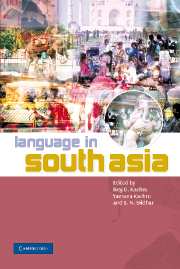Book contents
- Frontmatter
- Contents
- List of Figures
- List of Maps
- List of Tables
- Preface
- Acknowledgments
- List of Abbreviations
- Note on Transcription
- Introduction: languages, contexts, and constructs
- Part 1 Language history, families, and typology
- Part 2 Languages and their functions
- Part 3 Sanskrit and traditions of language study
- Part 4 Multilingualism, contact, and convergence
- Part 5 Orality, literacy, and writing systems
- Part 6 Language conflicts
- Part 7 Language and modernization
- Part 8 Language and discourse
- Part 9 Language and identity
- Part 10 Languages in diaspora
- References
- Subject Index
- Language Index
- Author Index
- References
Preface
Published online by Cambridge University Press: 04 May 2010
- Frontmatter
- Contents
- List of Figures
- List of Maps
- List of Tables
- Preface
- Acknowledgments
- List of Abbreviations
- Note on Transcription
- Introduction: languages, contexts, and constructs
- Part 1 Language history, families, and typology
- Part 2 Languages and their functions
- Part 3 Sanskrit and traditions of language study
- Part 4 Multilingualism, contact, and convergence
- Part 5 Orality, literacy, and writing systems
- Part 6 Language conflicts
- Part 7 Language and modernization
- Part 8 Language and discourse
- Part 9 Language and identity
- Part 10 Languages in diaspora
- References
- Subject Index
- Language Index
- Author Index
- References
Summary
This volume is the sixth in the series initiated by Cambridge University Press twenty-six years ago. The first book in the series was Language in the USA, edited by Charles A. Ferguson and Shirley Brice Heath (1981). The inspiration for the present volume on Language in South Asia came from Ferguson and Heath's pathbreaking contribution. It was the late Professor Ferguson who, in his inimitably persuasive way, suggested to one of the editors of the present volume the desirability and importance of a book on Language in South Asia. That was in the late 1970s, when Language in the USA was in the final stages of publication.
Charles A. Ferguson, affectionately called Fergi, was a committed scholar in South Asian linguistics in more than one sense. Thom Huebner, once a faculty colleague of Ferguson at Stanford University, succinctly summarizes Ferguson's “longest standing interests” in South Asia that goes back to 1945. It was then that Ferguson published his first article on South Asian linguistics. Since then, adds Huebner,
he has published nearly twenty others, he has co-edited a major volume on the topic (Ferguson and Gumperz, 1960), and there has been at least one volume of South Asian linguistics dedicated to him (Krishnamurti, 1986). In “South Asia as a Sociolinguistic Area,” Ferguson highlights some features of language use that make South Asia unique. In the process he demonstrates how features of language use just as well as language structure can cluster in real relationships. Not only does the paper deepen the reader's understanding of the region, it also suggests that this type of research into the language situation of a larger geographical region can have implications for theories of language change and cultural diffusion in general.
(1996: 21)- Type
- Chapter
- Information
- Language in South Asia , pp. xv - xviPublisher: Cambridge University PressPrint publication year: 2008

